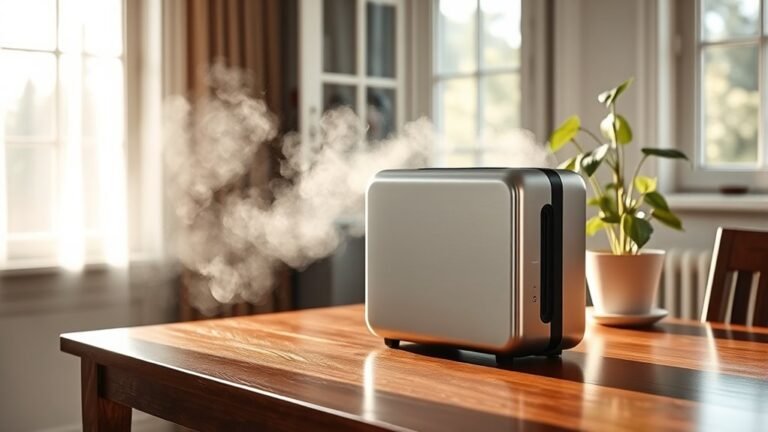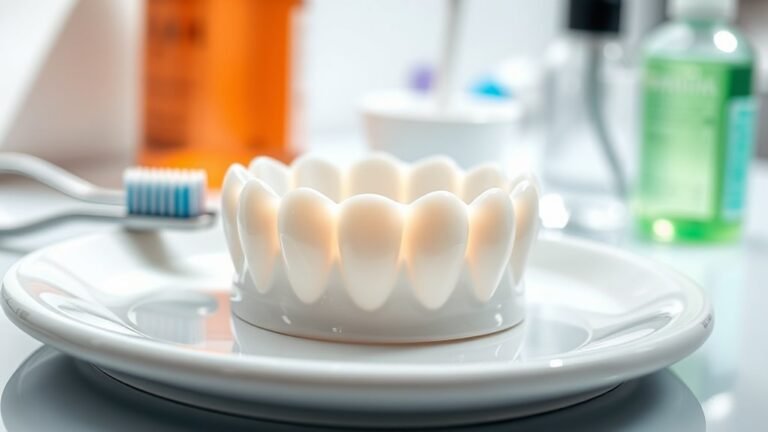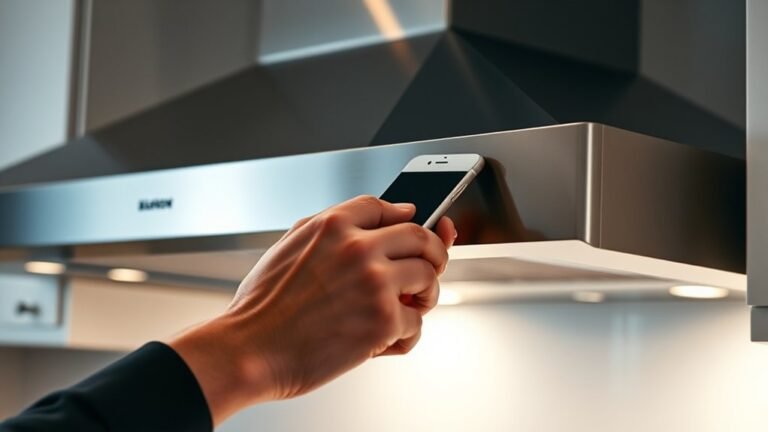Deep Cleaning Guide for Car Flooring
To deep clean your car flooring, start by clearing out belongings and loose debris. Use a quality vacuum with crevice tools to remove dirt, then treat stains gently with appropriate cleaners. Rubber and vinyl mats need a mild soap scrub and thorough rinsing. After cleaning, dry completely to prevent mold by airing out the car or using a fan. Protect your floors with durable mats and maintain cleanliness with regular vacuuming. Keep going to discover all the best tips for a spotless interior.
Preparing Your Car for Deep Cleaning

Before diving into deep cleaning your car flooring, you’ll want to clear out any belongings and loose debris. This step is essential for evaluating condition accurately and ensuring nothing gets in your way. Take a moment to organize belongings—put things in designated containers or bags to avoid clutter returning quickly. As you remove items, inspect the flooring for stains, tears, or worn spots. Evaluating condition now lets you tailor your cleaning approach, saving time and effort later. By preparing your car this way, you create a clean slate that’s ready for a thorough refresh. This simple preparation aligns with your desire for freedom, making the cleaning process smoother and more effective without unnecessary hassle or distractions.
Essential Tools and Cleaning Products
To get your car flooring spotless, you’ll need the right tools and cleaning products. Picking the best vacuum, brushes, and stain removers can make the job much easier. Let’s take a look at the essentials you should have on hand before you start.
Must-Have Cleaning Tools
A few essential tools can make deep cleaning your car flooring much easier and more effective. Having the right gear lets you tackle dirt and grime without hassle, giving you the freedom to enjoy a spotless ride. Start with quality cleaning brushes—they reach deep into carpet fibers and crevices. Next, microfiber cloths are a must; they trap dust and moisture without scratching surfaces. Finally, a sturdy vacuum with a crevice tool attachment helps remove loose debris fast.
- Cleaning brushes for scrubbing stubborn dirt
- Microfiber cloths for gentle, effective wiping
- Vacuum with crevice tool for thorough debris removal
Equip yourself with these tools, and you’ll breeze through car floor cleaning, freeing up your time for what really matters.
Best Cleaning Products
Having the right tools sets you up for success, but picking the best cleaning products can make all the difference in how spotless your car flooring looks. You want products that clean deeply without harming your car or the environment. Eco friendly cleaners are a smart choice—they tackle grime effectively while keeping your space fresh and chemical-free. For stubborn stains and dirt embedded in fabric, high-quality upholstery cleaners are essential. They restore your car’s interior without leaving residues or harsh odors, giving you the freedom to enjoy a clean, healthy ride. Choose products that suit your flooring type, whether carpet or rubber mats, and always test a small area first. With the right cleaners, you’ll reclaim your car’s style and comfort, effortlessly.
Removing Loose Dirt and Debris

Before diving into deep cleaning, you’ll want to remove all loose dirt and debris from your car floors. Tackling loose debris first makes dirt removal more effective and prevents it from spreading during cleaning. Start by shaking out removable floor mats outside to free them from grit. Next, use a stiff brush or your hands to sweep away crumbs, leaves, and small stones stuck in corners or seams. Focus on areas where dirt tends to accumulate, like under seats and near door sills. By clearing this loose debris, you’ll set the stage for a thorough clean and enjoy a fresher, more open car space. Remember, freedom starts with a clean foundation!
Start your deep clean by removing loose dirt and debris for a fresher, more open car space.
- Shake out floor mats outdoors
- Brush away stubborn dirt in corners
- Target crevices and under seats for hidden debris
Vacuuming Techniques for Car Flooring
To get the best results, you’ll want to pick a vacuum designed for car interiors, ideally with strong suction and various attachments. Focus on using effective techniques, like vacuuming in multiple directions to lift dirt from fibers. This approach guarantees you remove even the hidden debris stuck deep in your car flooring.
Choosing the Right Vacuum
Picking the right vacuum can make a huge difference in how effectively you clean your car’s flooring. You want a tool that’s powerful yet portable, giving you freedom to reach every corner without hassle. When choosing, consider the different vacuum types and key vacuum features that suit your needs.
Here’s what to focus on:
- Vacuum types: Handheld models offer great maneuverability, while cordless options boost your mobility.
- Suction power: Strong suction lifts dirt embedded deep in fibers.
- Attachments: Crevice tools and brush heads help tackle tight spots and stubborn debris.
Effective Vacuuming Methods
Once you’ve chosen the right vacuum, knowing how to use it effectively will make your cleaning much more efficient. Start by removing floor mats and vacuuming them separately. Use advanced vacuuming techniques like adjusting attachments to reach under seats and tight corners. Move the vacuum slowly in multiple directions to lift embedded dirt from carpet fibers. Don’t forget to vacuum the edges and seams where debris loves to hide. For freedom from dirt, follow vacuuming frequency recommendations: weekly for heavy use, biweekly otherwise. This routine keeps your car floor fresh without hassle. Remember, consistent, targeted vacuuming is key to maintaining a clean interior and enjoying the freedom of a pristine ride wherever you go.
Treating and Removing Stains

Dealing with stains on your car floor can feel tricky, but a few targeted steps will make the process easier. First, identify the stain types—grease, mud, or food—since each needs a different approach. Then, use the right removal techniques to avoid damage and free yourself from stubborn marks.
Here’s how to tackle stains effectively:
- Blot fresh spills immediately to prevent setting.
- Use a mild detergent or specialized cleaner suited for your car flooring material.
- Gently scrub with a soft brush or cloth, avoiding harsh chemicals that can harm the surface.
Deep Cleaning Fabric Carpets
Before you start deep cleaning your fabric carpets, make sure to vacuum them thoroughly to remove loose dirt. Next, apply a suitable fabric cleaner to break down stains and grime. Finally, scrub gently and rinse well to leave your carpets fresh and clean.
Vacuum Thoroughly First
Start by vacuuming your car’s fabric carpets thoroughly to remove loose dirt, dust, and debris. Getting this step right sets the foundation for a deep clean, giving you that fresh, open feeling every time you hop in. When you’re ready to tackle vacuuming, keep these vacuuming tips in mind for efficient car vacuuming:
- Use a vacuum with strong suction and various attachments to reach tight spaces and under seats.
- Move slowly and cover every inch to lift hidden dirt trapped deep in the fibers.
- Empty the vacuum bag or canister regularly to maintain peak performance.
Use Fabric Cleaner
Once you’ve vacuumed thoroughly, it’s time to tackle the deeper grime embedded in your car’s fabric carpets. Using a fabric cleaner is crucial to break down stains and odors that a vacuum can’t reach. The fabric cleaner benefits go beyond just aesthetics—it revitalizes the fibers, making your car feel fresh and inviting again. To get the most out of your product, apply it evenly across the surface, allowing it to sit for a few minutes. This soaking period loosens dirt and lifts stains. When choosing fabric cleaner techniques, always test a small hidden area first to verify colorfastness. By following these steps, you reclaim your car’s interior freedom, keeping it clean without hassle or damage.
Scrub and Rinse
Grab a stiff-bristled brush to scrub your car’s fabric carpets after applying the cleaner. This step is essential to break down stubborn dirt and stains, freeing your carpets from grime. Use effective scrub techniques, working in circular motions to lift dirt without damaging fibers.
Once you’ve scrubbed thoroughly, it’s time to rinse. Proper rinse methods help remove residue and prevent re-soiling. Use a damp microfiber cloth or a gentle spray of water to blot away the cleaner.
Remember these key points:
- Apply firm, even pressure while scrubbing
- Avoid over-saturating the fabric during rinsing
- Use cool water for rinsing to protect carpet fibers
Caring for Rubber and Vinyl Floor Mats
Keeping your rubber and vinyl floor mats in top shape requires just a few simple steps. For effective rubber mat care, start by shaking off loose dirt and debris. Then, use a mild soap solution and a soft brush to scrub away stubborn grime without damaging the surface. Rinse thoroughly to remove all soap residue. When it comes to vinyl mat maintenance, avoid harsh chemicals that can cause cracking or fading. Instead, clean them gently with warm water and a non-abrasive cleaner. Regular wiping helps maintain flexibility and appearance. By sticking to these straightforward routines, you’ll keep your mats durable and looking fresh, giving you the freedom to enjoy your ride without worrying about worn-out flooring.
Drying and Preventing Mold
Although thorough cleaning is essential, drying your car flooring completely is just as important to prevent mold growth. Without proper drying techniques, moisture lingers, creating a perfect environment for mold. You want your car to smell fresh and stay healthy, right? Here’s how to nail mold prevention:
- Use absorbent towels or microfiber cloths to soak up excess water immediately after cleaning.
- Leave your car doors or windows open in a safe space to let air circulate and speed up drying.
- Consider using a portable fan or dehumidifier inside your car for stubborn damp spots.
Protecting Your Floors After Cleaning
Once your car floors are clean and dry, it’s crucial to protect them from dirt, spills, and wear to maintain their condition. Start by investing in quality floor mat protection—rubber or all-weather mats are ideal for trapping debris and preventing stains. These mats act as a barrier, saving your flooring from damage and making cleanup easier. You can also apply a fabric protector spray to carpeted areas to enhance stain prevention, helping resist spills and dirt absorption. Regularly check your mats for wear and replace them when necessary to keep your floors safeguarded. By taking these simple steps, you’ll preserve your car’s interior, allowing you to enjoy the freedom of a clean, fresh ride without constantly worrying about messes or damage.
Tips for Maintaining Clean Car Flooring
A few simple habits can make a big difference in maintaining your car flooring’s cleanliness. Embracing regular cleaning and proper floor mat maintenance lets you enjoy a fresh, unrestricted ride without worrying about dirt buildup. Keep your freedom to explore by following easy tips that save time and effort.
- Shake out and vacuum your floor mats weekly to prevent dirt embedding.
- Use a portable brush or vacuum for quick spot cleaning after outdoor adventures.
- Avoid eating or drinking in your car to minimize spills and stains.
Frequently Asked Questions
Can Professional Steam Cleaning Damage Car Flooring Materials?
You might wonder if professional steam cleaning can damage your car flooring. It’s important to know steam cleaning effectiveness depends on flooring material compatibility. Some materials handle steam well, while others might warp or discolor. To keep your freedom to enjoy a clean car without worry, always check if your flooring’s compatible with steam before opting for this method. That way, you get a deep clean without risking damage.
How Often Should Car Flooring Be Deep Cleaned for Allergy Prevention?
Think of your car flooring as a hidden garden where allergens sneak and grow. To keep allergy symptoms at bay, you should deep clean it every three to six months. Adjust your cleaning frequency based on how often you drive and if you notice sneezing or itching. Regularly renewing your car’s floors lets you breathe easy and keeps your freedom from allergy woes intact, so you can hit the road without worries.
Are DIY Deep Cleaning Methods Safe for Heated Car Floors?
You’ll want to be cautious with DIY deep cleaning methods on heated floors to guarantee cleaning safety. Using excessive water or harsh chemicals can damage the heating elements beneath your car’s flooring. Instead, opt for gentle, moisture-controlled techniques like vacuuming and using mild cleaners. This way, you maintain your freedom to clean thoroughly without risking your heated floors’ functionality or safety. Always check your car’s manual for specific recommendations.
What Are the Best Natural Cleaning Agents for Car Floors?
Did you know that 70% of people prefer eco friendly solutions for cleaning? When it comes to your car floors, natural agents like white vinegar, baking soda, and lemon juice work wonders for stain removal without harsh chemicals. You’ll love how these simple, free ingredients give you the freedom to keep your ride fresh and clean, all while protecting the environment and your health. Give them a try!
Can Deep Cleaning Improve the Resale Value of a Car?
Absolutely, deep cleaning can boost your car’s resale benefits by making it look and feel well-maintained. When you keep up a regular cleaning frequency, you not only preserve the car’s interior but also create a positive impression for potential buyers. This attention to detail shows you care, which can translate into higher offers and quicker sales, giving you more freedom to move on to your next adventure without hassle.






